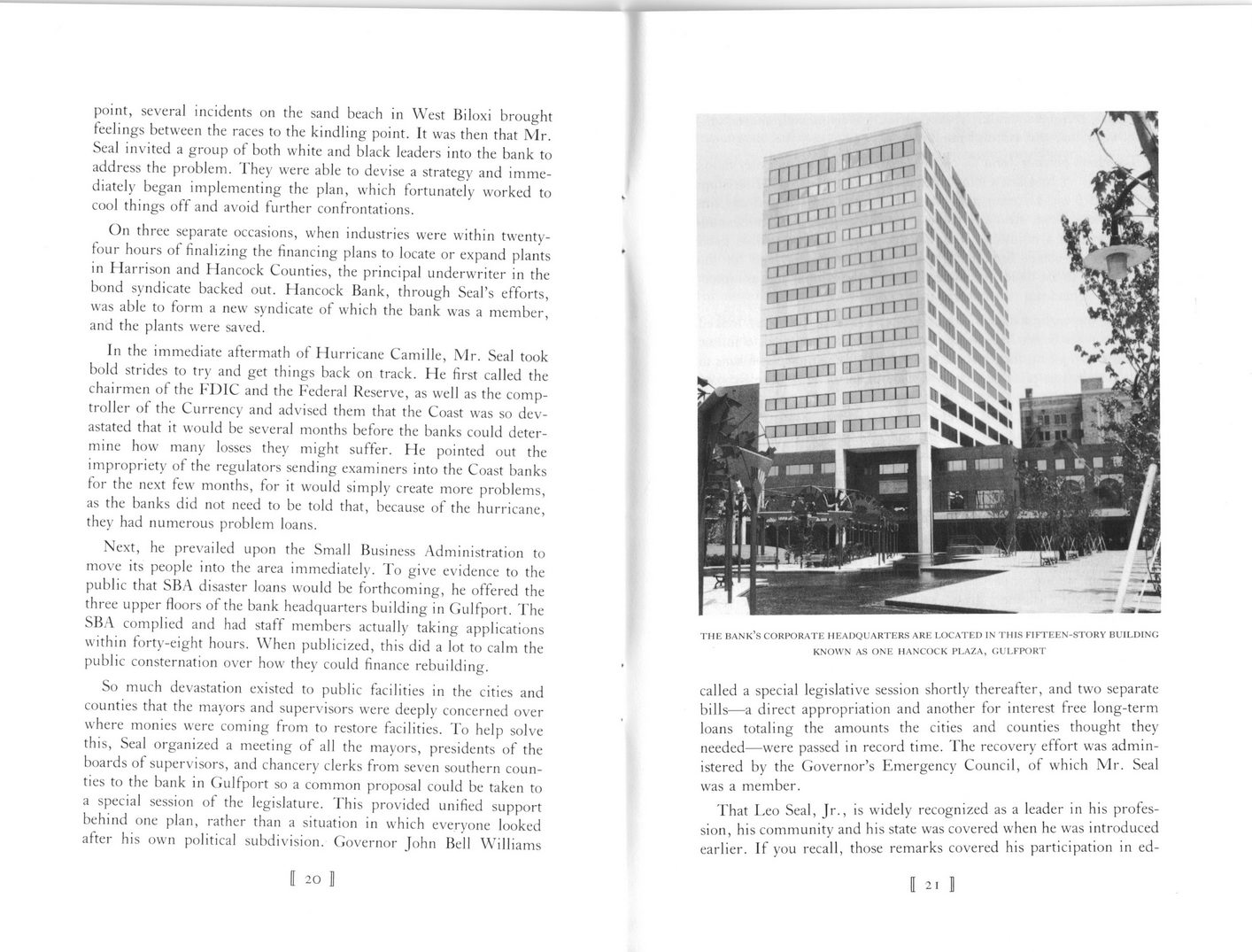This text was obtained via automated optical character recognition.
It has not been edited and may therefore contain several errors.
point, several incidents on the sand beach in West Biloxi brought feelings between the races to the kindling point. It was then that Mr. Seal invited a group of both white and black leaders into the bank to address the problem. They were able to devise a strategy and immediately began implementing the plan, which fortunately worked to cool things off and avoid further confrontations. On three separate occasions, when industries were within twenty-tour hours of finalizing the financing plans to locate or expand plants in Harrison and Hancock Counties, the principal underwriter in the bond syndicate backed out. Hancock Bank, through Seal’s efforts, was able to form a new syndicate of which the bank was a member, and the plants were saved. In the immediate aftermath of Hurricane Camille, Mr. Seal took bold strides to try and get things back on track. He first called the chairmen of the FDIC and the Federal Reserve, as well as the comptroller of the Currency and advised them that the Coast was so devastated that it would be several months before the banks could determine how many losses they might suffer. He pointed out the impropriety of the regulators sending examiners into the Coast banks for the next few months, for it would simply create more problems, as the banks did not need to be told that, because of the hurricane, they had numerous problem loans. Next, he prevailed upon the Small Business Administration to move its people into the area immediately. To give evidence to the public that SBA disaster loans would be forthcoming, he offered the three upper floors of the bank headquarters building in Gulfport. The SBA complied and had staff members actually taking applications within forty-eight hours. When publicized, this did a lot to calm the public consternation over how they could finance rebuilding. So much devastation existed to public facilities in the cities and counties that the mayors and supervisors were deeply concerned over where monies were coming from to restore facilities. To help solve this, Seal organized a meeting of all the mayors, presidents of the boards of supervisors, and chancery clerks from seven southern counties to the bank in Gulfport so a common proposal could be taken to a special session of the legislature. This provided unified support behind one plan, rather than a situation in which everyone looked after his own political subdivision. Governor John Bell Williams rm 11 • rrrrrm n / * —-rrrrrrr rrrrrm LLLUJTI ITTTTTn riiTTTn rrrrxrn , CU..H l u rrrn 111 oodjjjj nrrrrrn ^cctttttj THE BANK’S CORPORATE HEADQUARTERS ARE LOCATED IN THIS FIFTEEN-STORY BUILDING KNOWN AS ONE HANCOCK PI.AZA, GULFPORT called a special legislative session shortly thereafter, and two separate bills—a direct appropriation and another for interest free long-term loans totaling the amounts the cities and counties thought they needed—were passed in record time. The recovery effort was administered by the Governor’s Emergency Council, of which Mr. Seal was a member. That Leo Seal, Jr., is widely recognized as a leader in his profession, his community and his state was covered when he was introduced earlier. If you recall, those remarks covered his participation in ed- II 21 1

Hancock Bank Leo-Seal-Leading-The-Way-(1987)-11